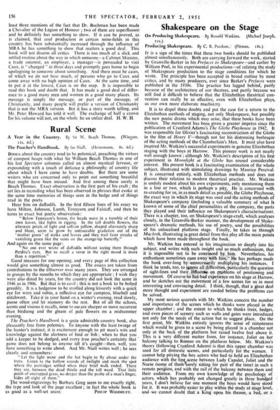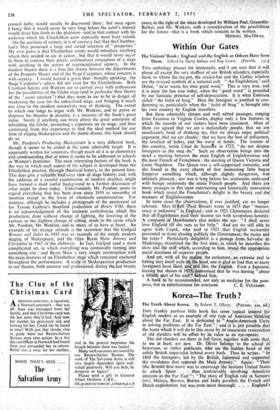Shakespeare on the Stage
On Producing Shakespeare. By Ronald Watkins, (Michael Joseph.
2 IS,)
Producing Shakespeare. By C. B. Purdom.: (Pitman. i Ss.)
Ir is a sign of the times that these two books should be published almost simultaneously. Both are carrying forward the work, started by Granville-Barker in his Prefaces to Shakespeare—and earlier by William Pod, in his experimental productions—of relating the study of Shakespeare production to the stage conditions for which he wrote. The principle has been accepted in broad outline by most critics, and by many producers, ever since Barker's Prefaces were published in the 1930s. The practice has lagged behind, partly because of the architecture of our theatres, and partly because we still find it difficult to believe that the Elizabethan theatrical con- vention can really be as effective, even with Elizabethan plays, as our own more elaborate machinery.
It is to dispel these doubts and put the case for a return to the Elizabethan methods of staging, not only Shakespeare, but possibly the new poetic drama which may arise, that these books have been written. The movement has been given a greater impetus since the publication of Cranford Adams's The Globe Playhouse in 1942. It was responsible for Olivier's fascinating reconstruction of the Globe in the film of Henry V-though not for his distressing burlesque of the acting methods of the Chamberlain's Men. It must also have inspired Mr. Watkins's successful experiments in genuine Elizabethan staging with the boys at Harrow. This pioneer work is not nearly well enough known ; although Mr. Watkins's description of his first experiment in Moonlight at the Globe has roused considerable interest. His present book is a fascinating examination of the whole subject, illustrated with stimulating drawings by Maurice Percival. It is concerned entirely. with Elizabethan methods and does not discuss their relation to modern theatrical practice. Mr. Watkins is unduly modest about his own experiments, only mentioning them in a line or two, which is perhaps a pity. He is concerned with re-creating for us, in as much detail as possible, the Globe Playhouse, the exact way in which its stage was used and the acting methods of Shakespeare's company (including a valuable summary of what Is known of some of the chief personalities of the company, the parts they played and their influence on Shakespeare's characterisation). There is a chapter, too, on Shakespeare's stage-craft, which ,analyses closely, in the Granville-Barker manner, the development of Shake- speare's dramatic methods, his use of poetry, 'and the possibilities of his unlocalised platform stage. Finally, he takes us through Macbeth. illustrating in great detail from this play all the main points which have been made throughout the book.
Mr. Watkins has entered in his imagination so deeply into his subject, and writes with such insight and so much enthusiasm, that it is impossible not to be convinced by him. Nevertheless, his
enthusiasm sometimes runs away with him.'," He has perhaps made the book over-long by unnecessarily multiplying his instances. I think he tends, too, to ignore all difficulties..-panicularly the question of sight-lines and their rrtflue, Use op prpblems of positioning and movement. Of course he has had experience on his stage at Harrow, and he sketches out the movement of a few scenes for us, in most interesting and convincing detail. I think, though, that a great deal more thought and experiment are needed before the problems can be solved.
My most serious quarrels with Mr. Watkins concern the number and importance of the scenes which he thinks were played in the upper chamber ; and the extent to which he thinks trees, hedges,
and even pieces of scenery such as walls and gates were introduced not only for the needs of the action but to suggest place. On the first point, Mr. Watkins entirely ignores the sense of remoteness which would be given- to a scene by being played in a chamber not only at the back of the platform but raised twelve feet above it.
This is a very different matter from, for instance, Juliet on her balcony talking to Romeo on the platform below. Mr. Watkins's theory (following Cranford Adams) is that this upper chamber was used for all domestic scenes, and particularly for the women. I cannot help pitying the boy actors who had to hold an Elizabethan audience with the fire .scene between Lady Capulet, Juliet and the Nurse (some of them' urely sitting for part of the time) in such a remote position, and with the rail of the balcony between them and their audience. From my own knowledge of the psychology of actors, which has probably not changed greatly in three hundled years, I don't believe for one moment the boys would have stood for it. It was probably easier to play within the study at stage level, and we cannot doubt that a King upon his throne, a bed, or a
council table, would usually be discovered there ; but once again I fancy that it would never be very long before the actor's instinct would drive him forth to the platform—and to that contact with his audience which the Elizabethan actor especially must have valued. On the question of scenery, it is of course a fact that the Chamber- lain's Men possessed a large and varied selection of " properties." My own guess is that Elizabethan actors would introduce anything which they needed to use in action ; but that it would never occur to them to confuse their purely architectural conception of a stage with anything in the nature of representational scenery. In the modern theatre there is a firm line drawn between the departments of the Property Master and of the Stage Carpenter, whose concern is with scenery. I would hazard a guess that—broadly speaking—the Stage Carpenter's sphere did not exist for the Elizabethans. Both Cranford Adams and Watkins are so carried away with enthusiasm for the possibilities of the Globe stage (and in particular their theory of the " scene rotation ") that they seem to me to be in danger of weakening the case for the unlocalised stage, and bringing it much too close to the modern naturalistic way of thinking. The extent to which one longs to argue with Mr. Watkins, and to prove or disprove his theories in practice, is a measure of the book's great value. Surely if anything can bring about the great enterprise of rebuilding the Globe, presenting a repertoire on its stage, and then continuing from this experience to find the ideal method for our time of staging Shakespeare and the poetic drama, this book should do so.
Mr. Purdom's Producing Shakespeare is a very different book, though it seems to be aimed at the same admirable target. It is apparently written for amateurs, though much of it is so elementary and condescending that at times it seems to be addressed to schools or Women's Institutes. The most interesting feature of the book is the way in which each aspect of the subject is developed from the Elizabethan practice, through theatrical history, to the present time. This does give a valuable bird's-eye view of stage history, and, with the addition of a careful examination of modern practice, might have formed a most useful background to a further discussion of what might be done today. Unfortunately Mr. Purdom seems to regard everything that has been done since 1939 as unworthy of mention except in the form of wholesale condemnation. For instance, although he includes a photograph of the permanent set for Tyrone Guthrie's Stratford production of Henry VIII, there is no acknowledgement of the immense, contribution which this production, done without change of lighing, the lowering of the curtain, or the slightest change of setting, made to the cause which Mr. Purdom, Mr. Watkins, and so many of us have at heart. An example of his strange attitude is the statement that the Gielgud Romeo and Juliet in 1935 was an example of the simple modern staging of Shakespeare, and the Glen Byam Shaw Antony and Cleopatra in 1947 of the elaborate. In fact, Gielgud used a most complicated set, in which everything: was continually turning into something else ; and Byam Shaw a very simple construction with the main features of an Elizabethan stage which remained unaltered throughout the performance. A study of Shakespearian production in our theatre, both amateur and professional, during thalast twenty
years, in the light of the ideas developed LAy William Poel, Oranville- Barker, and Mr. Watkins, with a consideration of the possibilities for the future—that is a book which remains to be written.
MICHAEL MACOWAN.



































 Previous page
Previous page